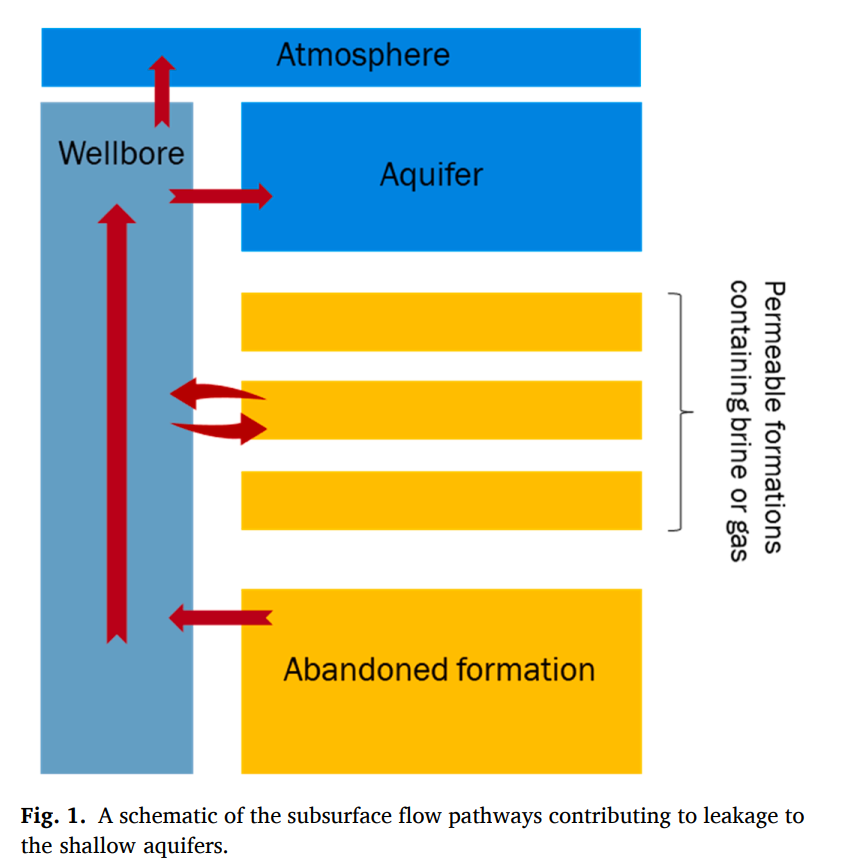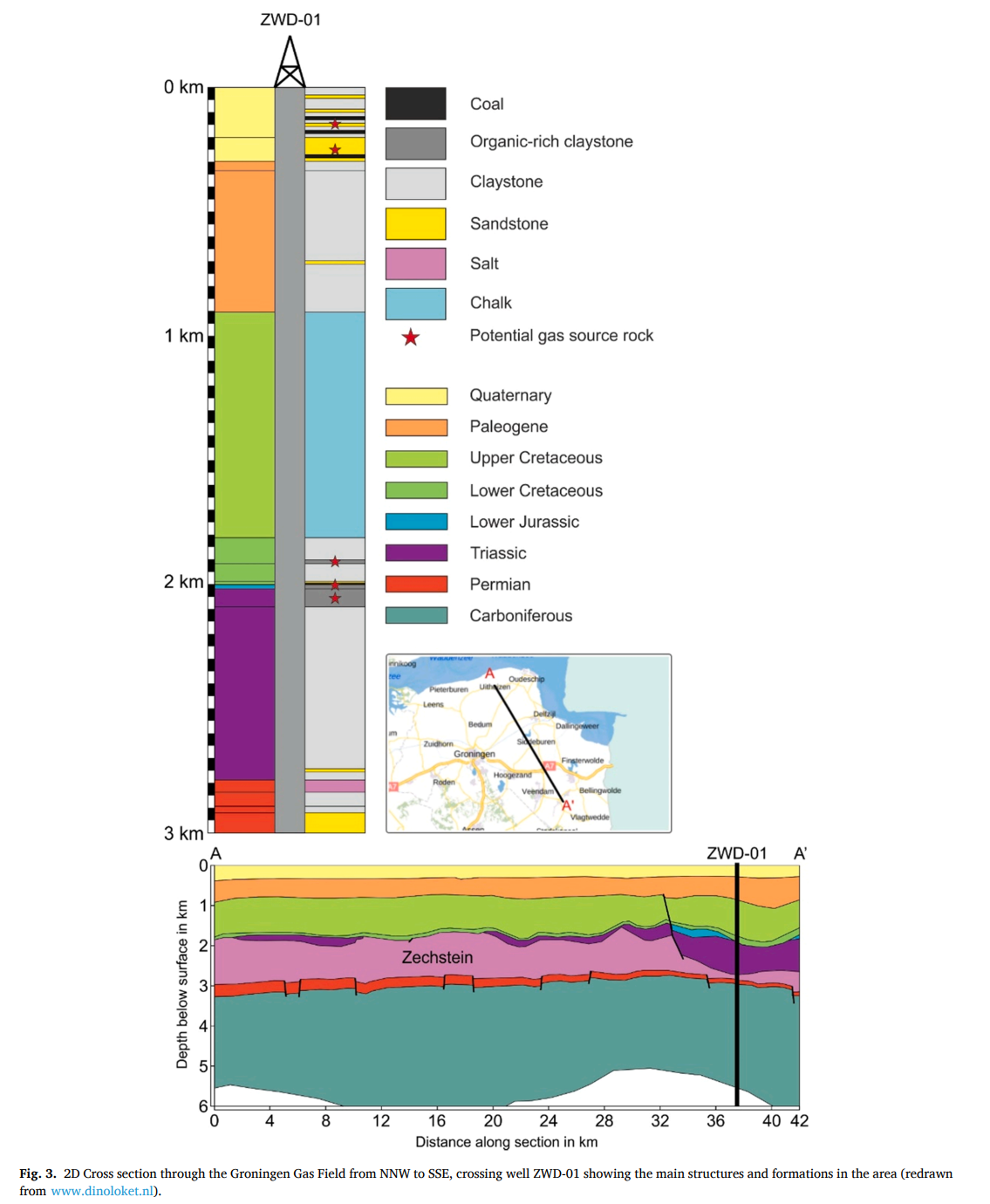Gas leakage from abandoned wells
- 在过去几十年里,荷兰的格罗宁根气田一直是欧洲主要的天然气供应来源。现如今,这座气田中约有350口井,其中一些已经被封堵并废弃,而其他的则将在不久的将来被封堵并废弃。在本研究中,我们利用了格罗宁根气田一口井的地层层序和岩石物理数据,开发了一个基于两相、两组分的数值模型。我们的研究重点在于估算废弃储层和浅层含气层中泄漏的甲烷量。甲烷是一种强效的温室气体,废弃井的甲烷泄漏问题引起了广泛关注。
- 研究结果显示,高度抽采的储层在不重新加压的情况下不太可能是泄漏的来源。然而,浅层含气层可能产生大量气体流,构成重要的泄漏风险。存在于气源和淡水含水层之间的具有渗透性的中间层可作为缓冲区,能够减少泄露进入大气/含水层系统的速率。
- 在水泥环受到轻微损坏(1 mD)且气源可靠的情况下,泄漏速率相对较低(每年少于30公斤甲烷)。然而,在高泄漏速率的情况下,泄漏速率可高达每年4500公斤,使得甲烷在100年后在淡水含水层中扩散至井距离450米的地方。
- 这项研究的结果有助于识别存在更高气体泄漏风险的井,以及评估这种现象对温室气体排放和当地淡水质量的影响。
The Groningen gas field in the Netherlands has been a major source of natural gas in Europe for the past few decades. There are approximately 350 wells drilled in the field that either already are or will be plugged and abandoned in the near future. In this work, we developed a two-phase, two-component numerical model based on the stratigraphy and the petrophysical data from a well in the Groningen field. The focus was to estimate the magnitude of methane leakage from the abandoned reservoir and the shallow gas-bearing formations. Methane is a potent greenhouse gas and fugitive methane emission from abandoned wells is of concern. The results indicate that highly depleted reservoirs are not a likely source of leakage, as long as they are not re-pressurized. However, shallow gas-bearing formations capable of bulk gas flow can pose a significant leakage risk. Permeable intermediate formations between the gas source and freshwater aquifers can act as a buffer zone, reducing the maximum rate of leakage into the atmosphere/aquifer system. For a mildly damaged cement sheath (1 mD) with a viable gas source, the leakage rate is relatively small (less than 30 kg/year of methane). The high leakage rate scenario results in a leakage rate as high as 4500 kg/year, with a methane plume in the freshwater aquifer that extends up to 450 m away from the well after 100 years. The results of this study can be used to identify wells that are at a higher risk of gas leakage, and the relative consequence of such phenomena on greenhouse gas emissions and local freshwater quality.




6. Conclusions
In this work, a numerical study was conducted on gas leakage from abandoned wells in the Groningen Field. The model included the main reservoir, intermediate formations, freshwater aquifers, the atmosphere (as a boundary condition), and the leakage pathway. The impact of reservoir pressure and the presence of shallow gas sources were investigated. The following conclusions can be drawn from this study:
– A depleted reservoir is not a likely source of gas leakage, as long as its pressure remains below a certain threshold that depends on the local subsurface conditions. This indicates that buoyancy and diffusive flow are not sufficient to cause significant leak rates in depleted reservoirs. Shallow gas-bearing formations are more likely to act as a leakage source if the permeability is sufficiently high and the gas saturation is above-critical to lead to bulk flow.
– For a mildly damaged cement sheath with an average permeability of 1 md, all scenarios show relatively low levels of gas leakage. The leakage rate for the present case study is estimated to be less than 20 kg/yr, well below average emissions of a dairy cow (100 kg/year). The plume size in the freshwater aquifer is also expected to be negligible.
– A high permeability leakage pathway (100 mD) can lead to significant leakage rates if a productive gas source is present. The simulation results show that for the system under study, the dissolved methane plume can travel as far as 450 m away from the wellbore in the Peelo aquifer, after 100 years. The expected leakage rates into the Peelo aquifer and atmosphere are expected to be 3400 kg/yr, and 800 kg/yr, respectively, for the most extreme case considered. Unconfined aquifers such as the Boxtel Formation do not store significant amounts of gas, as the invading gas ultimately escapes to the atmosphere.
– Permeable intermediate formations between the source and aquifers can act as a gas storage buffer. These formations can be critical in limiting the maximum rate of leakage into the atmosphere and freshwater aquifers. Capillary entry pressure and the permeability of the intermediate formations relative to the freshwater aquifers can determine the effectiveness of the leak buffer.
